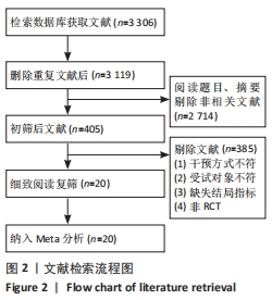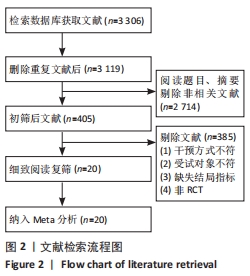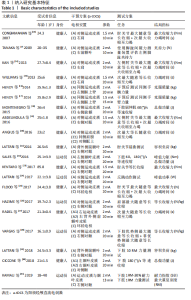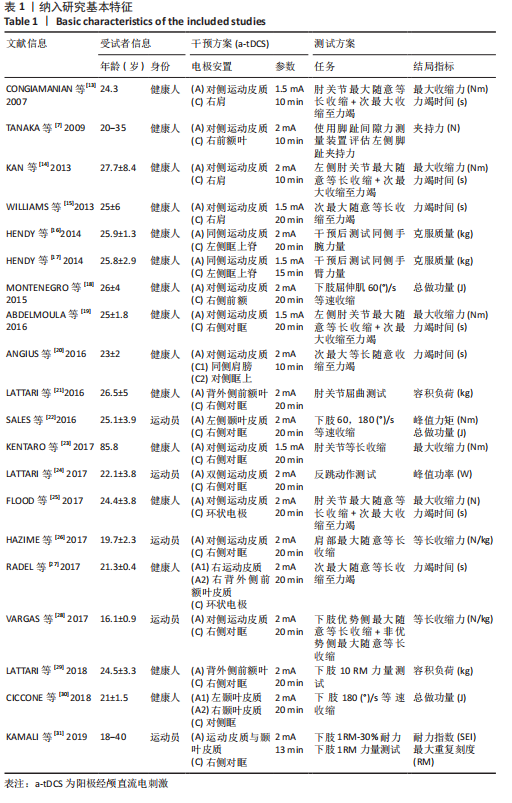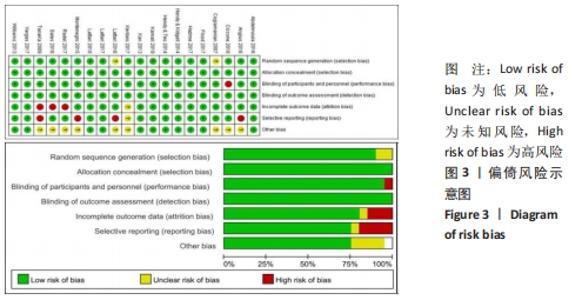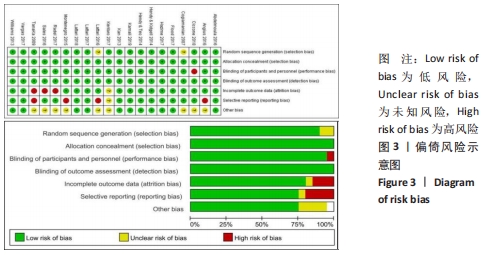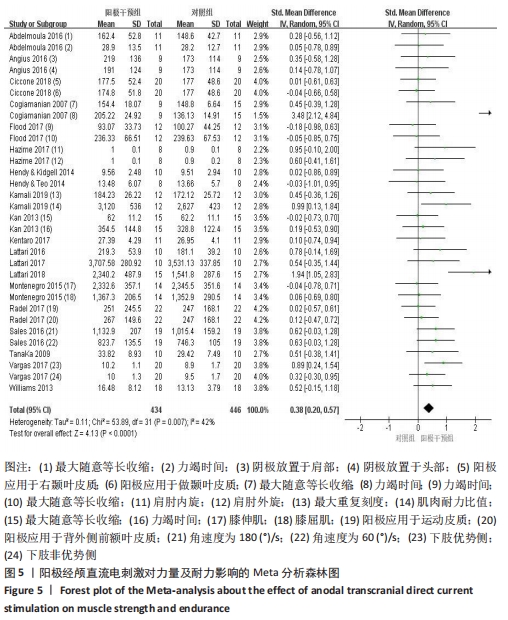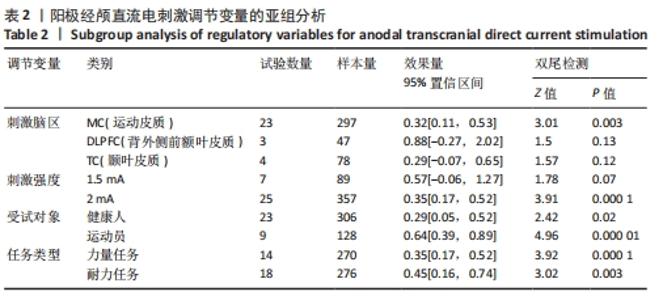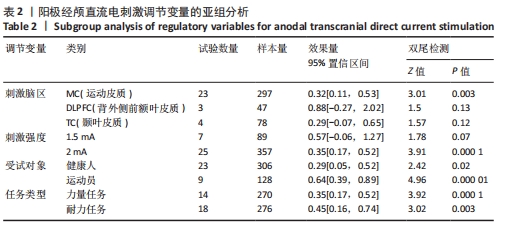Chinese Journal of Tissue Engineering Research ›› 2022, Vol. 26 ›› Issue (20): 3273-3280.doi: 10.12307/2022.632
Effect of anodal transcranial direct current stimulation on muscle strength and endurance: a Meta-analysis
Hao Zhixin1, Wu Yixin2, Wang Xin3, Xia Zhongliang4
- 1Office of Graduate Student Affairs, 2School of Human Movement Science, 3Social Science Research Center for Sports, 4School of Physical Education, Shenyang Sport University, Shenyang 110102, Liaoning Province, China
-
Received:2021-07-29Revised:2021-07-30Accepted:2021-08-24Online:2022-07-18Published:2022-01-20 -
Contact:Xia Zhongliang, PhD, Professor, School of Physical Education, Shenyang Sport University, Shenyang 110102, Liaoning Province, China -
About author:Hao Zhixin, Master candidate, Office of Graduate Student Affairs, Shenyang Sport University, Shenyang 110102, Liaoning Province, China -
Supported by:the National Key Research and Development Program of China, No. 2018YFF0300502 (to WX); Postgraduate Innovation Fund of Shenyang Sport University (to HZX)
CLC Number:
Cite this article
Hao Zhixin, Wu Yixin, Wang Xin, Xia Zhongliang. Effect of anodal transcranial direct current stimulation on muscle strength and endurance: a Meta-analysis[J]. Chinese Journal of Tissue Engineering Research, 2022, 26(20): 3273-3280.
share this article
Add to citation manager EndNote|Reference Manager|ProCite|BibTeX|RefWorks

2.5.1 刺激脑区的亚组分析结果 Meta分析结果显示,阳极经颅直流电刺激干预运动皮质对肌肉力量影响效果量为ES=0.32,95%Cl[0.11,0.53](P < 0.05),表明应用阳极经颅直流电刺激于运动皮质具备增强效果;阳极经颅直流电刺激干预背外侧前额叶皮质对肌肉力量影响效果量为ES=0.88,95%Cl[-0.27,2.02] (P > 0.05),表明应用阳极经颅直流电刺激于背外侧前额叶皮质具有积极效果,但效果不显著;阳极经颅直流电刺激干预颞叶皮质对肌肉力量影响效果量为ES=0.29,95%Cl[-0.07,0.65] (P > 0.05),表明应用阳极经颅直流电刺激于颞叶皮质具备增强效果,但效果不显著。 2.5.2 刺激强度的亚组分析结果 Meta分析结果显示,施加1.5 mA电流强度的阳极经颅直流电刺激效果量为ES=0.57,95%Cl[-0.06,1.27] (P > 0.05),表明应用1.5 mA强度的阳极经颅直流电刺激具备增强效果,但效果不显著;施加2 mA电流强度的阳极经颅直流电刺激效果量为ES=0.35,95%Cl[0.17,0.52] (P < 0.05),表明应用2 mA的阳极经颅直流电刺激具备增强效果。 2.5.3 受试对象的亚组分析结果 Meta分析结果显示,阳极经颅直流电刺激影响健康人的效果量为ES=0.29,95%Cl[0.05,0.52](P < 0.05),表明阳极经颅直流电刺激对健康人具备增益效果;阳极经颅直流电刺激影响运动员的效果量为ES=0.64,95%Cl[0.39,0.89](P < 0.05),表明阳极经颅直流电刺激对运动员的增益效果显著。 2.5.4 任务类型的亚组分析结果 Meta分析结果显示,阳极经颅直流电刺激影响力量性任务效果量为ES=0.35,95%Cl[0.17,0.52](P < 0.05),表明阳极经颅直流电刺激具备增强肌肉力量效果;阳极经颅直流电刺激影响耐力性任务效果量为ES=0.45,95%Cl[0.16,0.74] (P < 0.05),表明阳极经颅直流电刺激具备提升肌肉耐力水平。"

| [1] NITSCHE MA, PAULUS W. Excitability changes induced in the human motor cortex by weak transcranial direct current stimulation. J Physiol. 2000;527 Pt 3:633-639. [2] NITSCHE MA, FRICKE K, HENSCHKE U, et al. Pharmacological modulation of cortical excitability shifts induced by transcranial direct current stimulation in humans. J Physiol. 2003;553(Pt 1):293-301. [3] FREGNI F, BOGGIO PS, LIMA MC, et al. A sham-controlled, phase II trial of transcranial direct current stimulation for the treatment of central pain in traumatic spinal cord injury. Pain. 2006; 122(1-2):197-209. [4] BENNINGER DH, LOMAREV M, LOPEZ G, et al. Transcranial direct current stimulation for the treatment of Parkinson’s disease. J Neurol Neurosurg Psychiatry. 2010;81(10):1105-1111. [5] CELNIK P, PAIK NJ, VANDERMEEREN Y, et al. Effects of combined peripheral nerve stimulation and brain polarization on performance of a motor sequence task after chronic stroke. Stroke. 2009;40(5):1764-1771. [6] HORNYAK T. Smarter, not harder. Nature. 2017; 549(7670):S1-S3. [7] TANAKA S, HANAKAWA T, HONDA M, et al. Enhancement of pinch force in the lower leg by anodal transcranial direct current stimulation. Exp Brain Res. 2009;196(3):459-465. [8] OKANO AH, FONTES EB, MONTENEGRO RA, et al. Brain stimulation modulates the autonomic nervous system, rating of perceived exertion and performance during maximal exercise. Br J Sports Med. 2015;49(18):1213-1218. [9] POLANIA R, PAULUS W, NITSCHE MA. Modulating cortico-striatal and thalamo-cortical functional connectivity with transcranial direct current stimulation. Hum Brain Mapp. 2012;33(10):2499-2508. [10] MACHADO S, JANSEN P, ALMEIDA V, et al. Is tDCS an Adjunct Ergogenic Resource for Improving Muscular Strength and Endurance Performance? A Systematic Review. Front Psychol. 2019;10:1127. [11] 屈云,何俐,刘鸣.Cochrane系统评价的基本方法[J].中国临床康复,2003,7(4):532-533+536. [12] 李静,李幼平.不断完善与发展的Cochrane系统评价[J].中国循证医学杂志,2008,8(9): 742-743. [13] COGIAMANIAN F, MARCEGLIA S, ARDOLINO G, et al. Improved isometric force endurance after transcranial direct current stimulation over the human motor cortical areas. Eur J Neurosci. 2007;26(1):242-249. [14] KAN B, DUNDAS JE, NOSAKA K. Effect of transcranial direct current stimulation on elbow flexor maximal voluntary isometric strength and endurance. Appl Physiol Nutr Metab. 2013;38(7):734-739. [15] WILLIAMS PS, HOFFMAN RL, CLARK BC. Preliminary evidence that anodal transcranial direct current stimulation enhances time to task failure of a sustained submaximal contraction. PLoS One. 2013;8(12):e81418. [16] HENDY AM, KIDGELL DJ. Anodal-tDCS applied during unilateral strength training increases strength and corticospinal excitability in the untrained homologous muscle. Exp Brain Res. 2014;232(10):3243-3252. [17] HENDY AM, TEO WP, KIDGELL DJ. Anodal Transcranial Direct Current Stimulation Prolongs the Cross-education of Strength and Corticomotor Plasticity. Med Sci Sports Exerc. 2015;47(9):1788-1797. [18] Montenegro R, ALEXANDRE O, JONAS G, et al. Motor cortex tDCS does not improve strength performance in healthy subjects. Motriz. 2015;21(2):185-193. [19] ABDELMOULA A, BAUDRY S, DUCHATEAU J. Anodal transcranial direct current stimulation enhances time to task failure of a submaximal contraction of elbow flexors without changing corticospinal excitability. Neuroscience. 2016; 322:94-103. [20] ANGIUS L, PAGEAUX B, HOPKER J, et al. Transcranial direct current stimulation improves isometric time to exhaustion of the knee extensors. Neuroscience. 2016; 339:363-375. [21] LATTARI E, ANDRADE ML, FILHO AS, et al. Can Transcranial Direct Current Stimulation Improve the Resistance Strength and Decrease the Rating Perceived Scale in Recreational Weight-Training Experience. J Strength Cond Res. 2016;30(12):3381-3387. [22] SALES M, BROWNE R, et al. Transcranial direct current stimulation improves muscle isokinetic performance of young trained individuals. Med Sport. 2016;69:1-10. [23] Kentaro O, CLARK LA, AMANO S, et al. Effect of Anodal Transcranial Direct Current Stimulation of the Motor Cortex on Elbow Flexor Muscle Strength in the Very Old. J Geriatr Phys Ther. 2017;42(4):243-248. [24] LATTARI E, CAMPOS C, LAMEGO MK, et al. Can Transcranial Direct Current Stimulation Improve Muscle Power in Individuals With Advanced Weight-Training Experience. J Strength Cond Res. 2020;34(1):97-103. [25] FLOOD A, WADDINGTON G, KEEGAN RJ, et al. The effects of elevated pain inhibition on endurance exercise performance. Peer J. 2017;5:e3028. [26] HAZIME F A, DA CUNHA RA, SOLIAMAN RR, et al. Anodal Transcranial Direct Current Stimulation (Tdcs) Increases Isometric Strength of Shoulder Rotators Muscles in Handball Players. Int J Sports Phys Ther. 2017;12(3):402-407. [27] RADEL R, TEMPEST G, DENIS G, et al. Extending the limits of force endurance: Stimulation of the motor or the frontal cortex. Cortex. 2017; 97:96-108. [28] VARGAS VZ, BAPTISTA AF, PEREIRA G OC, et al. Modulation of Isometric Quadriceps Strength in Soccer Players With Transcranial Direct Current Stimulation: A Crossover Study. J Strength Cond Res. 2018;32(5):1336-1341. [29] LATTARI E, ROSA FILHO BJ, FONSECA JUNIOR SJ, et al. Effects on Volume Load and Ratings of Perceived Exertion in Individuals’ Advanced Weight Training After Transcranial Direct Current Stimulation. J Strength Cond Res. 2020;34(1):89-96. [30] CICCONE AB, DECKERT JA, SCHLABS CR, et al. Transcranial Direct Current Stimulation of the Temporal Lobe Does Not Affect High-Intensity Work Capacity. J Strength Cond Res. 2019;33(8):2074-2086. [31] KAMALI AM, SAADI ZK, YAHYAVI SS, et al. Transcranial direct current stimulation to enhance athletic performance outcome in experienced bodybuilders. PLoS One. 2019; 14(8):e0220363. [32] 吕季东,俞继英,龙跃玉,等.专项力量概念的界定[J].上海体育学院学报,2004, 28(4):24-28. [33] 田石榴,刘宇.负重超等长力量训练的神经肌肉适应机制研究[J].医用生物力学, 2009(S1):137. [34] NITSCHE MA, LIEBETANZ D, LANG N, et al. Safety criteria for transcranial direct current stimulation (tDCS) in humans. Clin Neurophysiol. 2003;114(11): 2220-2222; author reply 2-3. [35] ARDOLINO G, BOSSI B, BARBIERI S, et al. Non-synaptic mechanisms underlie the after-effects of cathodal transcutaneous direct current stimulation of the human brain. J Physiol. 2005;568(Pt 2):653-663. [36] LANG N, SIEBNER HR, WARD NS, et al. How does transcranial DC stimulation of the primary motor cortex alter regional neuronal activity in the human brain. Eur J Neurosci. 2005;22(2):495-504. [37] SEMMLER JG, KUTZSCHER DV, ENOKA RM. Limb immobilization alters muscle activation patterns during a fatiguing isometric contraction. Muscle Nerve. 2000;23(9):1381-1392. [38] 梁成军.肌肉力量训练神经适应机制研究综述[J].吉林体育学院学报,2013,29(3):14-17. [39] WANG X, WONG WW, FANG Y, et al. Dynamic Influence of Ongoing Brain Stimulation on Resting State fMRI Connectivity: A Concurrent tDCS-fMRI Study. Annu Int Conf IEEE Eng Med Biol Soc. 2018;2018:1037-1040. [40] 赵铁建,郭健. 神经生理学[M]. 2版.北京:人民卫生出版社,2018:159-164. [41] 王婕. 经颅直流电刺激的定向优化及机制研究[D].北京:清华大学,2016. [42] SEMMLER JG. Motor unit synchronization and neuromuscular performance. Exerc Sport Sci Rev. 2002;30(1):8-14. [43] FARINA D, NEGRO F. Common synaptic input to motor neurons, motor unit synchronization, and force control. Exerc Sport Sci Rev. 2015; 43(1):23-33. [44] DUTTA A, KRISHNAN C, KANTAK SS, et al. Recurrence quantification analysis of surface electromyogram supports alterations in motor unit recruitment strategies by anodal transcranial direct current stimulation. Restor Neurol Neurosci. 2015;33(5):663-669. [45] 齐玉刚,刘政宇,谭思洁.20~69岁人群肌肉耐力变化规律的试验研究[J].天津体育学院学报,2016,31(1):69-72. [46] ST CLAIR GIBSON A, NOAKES TD. Evidence for complex system integration and dynamic neural regulation of skeletal muscle recruitment during exercise in humans. Br J Sports Med. 2004;38(6):797-806. [47] LAMBERT EV, ST CLAIR GIBSON A, NOAKES TD. Complex systems model of fatigue: integrative homoeostatic control of peripheral physiological systems during exercise in humans. Br J Sports Med. 2005; 39:52-62. [48] MARCORA SM. Do we really need a central governor to explain brain regulation of exercise performance. Eur J Appl Physiol. 2008;104(5):929-931. [49] MARCORA SM, BOSIO A, DE MORREE HM. Locomotor muscle fatigue increases cardiorespiratory responses and reduces performance during intense cycling exercise independently from metabolic stress. Am J Physiol Regul Integr Comp Physiol. 2008; 294(3):R874-R883. [50] MARCORA S. Counterpoint: Afferent feedback from fatigued locomotor muscles is not an important determinant of endurance exercise performance. J Appl Physiol. 2010;108(2):454-456. [51] 周鹏,魏晋文,孙畅,等.经颅直流电刺激调控大脑认知功能的研究进展[J].中国生物医学工程学报,2018,37(2):208-214. [52] ANGIUS L, HOPKER J, MAUGER AR. The Ergogenic Effects of Transcranial Direct Current Stimulation on Exercise Performance. Front Physiol. 2017;8:90. [53] ANGIUS L, MAUGER AR, HOPKER J, et al. Bilateral extracephalic transcranial direct current stimulation improves endurance performance in healthy individuals. Brain Stimul. 2018;11(1):108-117. [54] ANGIUS L, SANTARNECCHI E, PASCUAL-LEONE A, et al. Transcranial Direct Current Stimulation over the Left Dorsolateral Prefrontal Cortex Improves Inhibitory Control and Endurance Performance in Healthy Individuals. Neuroscience. 2019;419:34-45. [55] TAYLOR JL, AMANN M, DUCHATEAU J, et al. Neural Contributions to Muscle Fatigue: From the Brain to the Muscle and Back Again. Med Sci Sports Exerc. 2016; 48(11):2294-2306. [56] GANDEVIA SC. Spinal and supraspinal factors in human muscle fatigue. Physiol Rev. 2001; 81(4):1725-1789. [57] REIDLER JS, MENDONCA ME, SANTANA MB, et al. Effects of motor cortex modulation and descending inhibitory systems on pain thresholds in healthy subjects. J Pain. 2012;13(5):450-458. [58] MAUGER AR. Fatigue is a pain-the use of novel neurophysiological techniques to understand the fatigue-pain relationship. Front Physiol. 2013;4:104. [59] MAUGER AR, JONES AM, WILLIAMS CA. Influence of acetaminophen on performance during time trial cycling. J Appl Physiol. 2010; 108(1):98-104. [60] LIU JZ, SHAN ZY, ZHANG LD, et al. Human brain activation during sustained and intermittent submaximal fatigue muscle contractions: an FMRI study. J Neurophysiol. 2003;90(1):300-312. [61] ROBERTSON CV, MARINO FE. A role for the prefrontal cortex in exercise tolerance and termination. J Appl Physiol. 2016;120(4):464-466. [62] PAGEAUX B. The psychobiological model of endurance performance: an effort-based decision-making theory to explain self-paced endurance performance. Sports Med. 2014;44(9):1319-1320. [63] WILLIAMSON JW. The relevance of central command for the neural cardiovascular control of exercise. Exp Physiol. 2010;95(11):1043-1048. [64] TULPPO MP, MAKIKALLIO TH, SEPPANEN T, et al. Vagal modulation of heart rate during exercise: effects of age and physical fitness. Am J Physiol. 1998;274(2):H424-H429. [65] FEBBRAIO MA. Exercise metabolism in 2016: Health benefits of exercise - more than meets the eye. Nat Rev Endocrinol. 2017;13(2):72-74. [66] CLASSEN J, LIEPERT J, WISE SP, et al. Rapid plasticity of human cortical movement representation induced by practice. J Neurophysiol. 1998;79(2):1117-1123. [67] LIEPERT J, CLASSEN J, COHEN LG, et al. Task-dependent changes of intracortical inhibition. Exp Brain Res. 1998;118(3):421-426. [68] KIDGELL DJ, BONANNO DR, FRAZER AK, et al. Corticospinal responses following strength training: a systematic review and meta-analysis. Eur J Neurosci. 2017;46(11):2648-2661. [69] 陈承宇,吴嘉敏,严进洪.体育运动训练增强肌肉可塑性和大脑可塑性[J].生理科学进展,2020,51(4):311-315. [70] BüHRLE M, SCHMIDTBLEICHER D. Komponenten der maximal und Schnellkraft-versuch einer Neustrukturierung auf Basis empirischer Ergebnisse. Sport Wiss Cht. 1981; 11:11-27. [71] 李智伟,伍朝明,顾心雨,等.经颅直流电刺激下健康成人肌肉力量及耐力表现的Meta分析[J].中国组织工程研究,2021, 25(29):4750-4756. [72] VITOR-COSTA M, OKUNO NM, BORTOLOTTI H, et al. Improving Cycling Performance: Transcranial Direct Current Stimulation Increases Time to Exhaustion in Cycling. PLoS One. 2015;10(12):e0144916. [73] ENOKA RM, BAUDRY S, RUDROFF T, et al. Unraveling the neurophysiology of muscle fatigue. J Electromyogr Kinesiol. 2011;21(2): 208-219. |
| [1] | Jing Jinpeng, Zhang Yue, Liu Xiaomin, Liu Yi. Traditional Chinese medicine injection for promoting blood circulation in prevention of deep vein thrombosis after orthopedic surgery: network meta-analysis [J]. Chinese Journal of Tissue Engineering Research, 2022, 26(9): 1467-1476. |
| [2] | Liu Gang, Ma Chao, Wang Le, Zeng Jie, Jiao Yong, Zhao Yi, Ren Jingpei, Hu Chuanyu, Xu Lin, Mu Xiaohong. Ankle-foot orthoses improve motor function of children with cerebral palsy: a Meta-analysis based on 12 randomized controlled trials [J]. Chinese Journal of Tissue Engineering Research, 2022, 26(8): 1299-1304. |
| [3] | Liu Yiyi, Qiu Junqiang, Yi Longyan, Zhou Cailiang. Effect of resistance training on interleukin-6 and C-reactive protein in middle-age and elderly people: a Meta-analysis [J]. Chinese Journal of Tissue Engineering Research, 2022, 26(5): 804-812. |
| [4] | Wang Nan, Qian Yuzhang, Xie Lin. Network Meta-analysis of different acupuncture methods for the treatment of lumbar disc herniation [J]. Chinese Journal of Tissue Engineering Research, 2022, 26(5): 813-820. |
| [5] | Wei Zhoudan, Li Wenjin, Zhu Li, Wang Yu, Zhao Jiaoyang, Chen Yanan, Guo Dong, Hao Min. Platelet-rich fibrin as a material for alveolar ridge preservation significantly reduces the resorption of alveolar bone height and width after tooth extraction: a meta-analysis [J]. Chinese Journal of Tissue Engineering Research, 2022, 26(4): 643-648. |
| [6] | Ou Liang, Kong Dezhong, Xu Daoqing, Ni Jing, Fu Xingqian, Huang Weichen. Comparative clinical efficacy of polymethyl methacrylate and self-solidifying calcium phosphate cement in vertebroplasty: a meta-analysis [J]. Chinese Journal of Tissue Engineering Research, 2022, 26(4): 649-656. |
| [7] | Yang Ruijia, Jiang Lingkai, Dong Zhengquan, Wang Yunfei, Ma Zhou, Cong Linlin, Guo Yanjing, Gao Yangyang, Li Pengcui. Open reduction and internal fixation versus circular external fixation for tibial plateau fractures: a meta-analysis [J]. Chinese Journal of Tissue Engineering Research, 2022, 26(3): 480-486. |
| [8] | Zhong Yuanming, He Bingkun, Wu Zhuotan, Wu Sixian, Wan Tong, Zhong Xifeng. Meta-analysis of efficacy and safety of Jack kyphoplasty for osteoporotic vertebral compression fractures [J]. Chinese Journal of Tissue Engineering Research, 2022, 26(3): 487-492. |
| [9] | Li Gaofeng, Wang Jun. Effects of concurrent aerobic and strength training on locomotor performance: a Meta-analysis [J]. Chinese Journal of Tissue Engineering Research, 2022, 26(26): 4258-4264. |
| [10] | Qiao Qiqi, Wu Yixin, Wang Xin, Xia Zhongliang. Effect of high-definition transcranial direct current stimulation on human dynamic balance [J]. Chinese Journal of Tissue Engineering Research, 2022, 26(26): 4192-4198. |
| [11] | Zhao Shuying, Guo Guangling, Liu Chenchen, Zhang Chao, Dong Sirui, Gong Qinqin, Ji Luwei. Stem cell transplantation in the treatment of premature ovarian failure: a meta-analysis based on 13 animal studies [J]. Chinese Journal of Tissue Engineering Research, 2022, 26(25): 4084-4092. |
| [12] | Shi Yao, Han Shufeng, Yuan Yitong, Du Ruochen, Jing Zhijie, Zhao Bichun, Zhang Ruxin, Zhang Yujuan, Wang Chunfang. Efficacy and safety of human umbilical cord mesenchymal stem cells in the treatment of spinal cord injury: a meta-analysis [J]. Chinese Journal of Tissue Engineering Research, 2022, 26(25): 4093-4100. |
| [13] | Diao Yulei, Zong Xiaorui, Deng Zhibo, Shu Han. Analgesic effect of adductor canal block versus femoral nerve block after autogenous bone-tendon-bone reconstruction of the anterior cruciate ligament: an updated Meta-analysis [J]. Chinese Journal of Tissue Engineering Research, 2022, 26(2): 315-320. |
| [14] | Zhou Junli, Wang Xiaojun, Wang Haijiao, Li Chun. A network meta-analysis of the efficacy of new medical dressings for diabetic foot ulcers [J]. Chinese Journal of Tissue Engineering Research, 2022, 26(16): 2562-2569. |
| [15] | Chen Keyi, Wang Dingxuan, Zhao Sike, Xia Zhangrong. Research hotspots of pressure training in rehabilitation and visualized analysis of relevant literature data in the past 10 years [J]. Chinese Journal of Tissue Engineering Research, 2022, 26(15): 2406-2411. |
| Viewed | ||||||
|
Full text |
|
|||||
|
Abstract |
|
|||||
